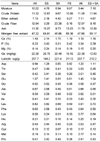1. Kozawa M, Morita N, Baba K, Hata K. Chemical components of the roots of
Angelica keiskei Koidzumi. II.
The structure of the chalcone derivatives. Yakugaku Zasshi. 1978. 98:210–214.

2. Kim OK, Kung SS, Park WB, Lee MW, Ham SS. The nutritional components of aerial whole plant and juice of Angelica keiskei Koidz. Korean J Food Sci Technol. 1992. 24:592–596.
3. Mitsuhashi H. Illustrated Medicinal Plants of the World in Colour. 1988. Tokyo: Hokuryukan;350.
4. Eyre H, Kahn R, Robertson RM. ACS/ADA/AHA Collaborative Writing Committee. Preventing cancer, cardiovascular disease, and diabetes: a common agenda for the American Cancer Society, the American Diabetes Association, and the American Heart Association. CA Cancer J Clin. 2004. 54:190–207.

5. Hirayama T. Knudsen I, editor. Nutrition and cancer - a large scale cohort study. Genetic Toxicology of the Diet. 1986. New York: Liss Inc;94.
6. Neuhouser ML. Dietary flavonoids and cancer risk: evidence from human population studies. Nutr Cancer. 2004. 50:1–7.

7. Mojzisová G, Kuchta M. Dietary flavonoids and risk of coronary heart disease. Physiol Res. 2001. 50:529–535.
8. Ross JA, Kasum CM. Dietary flavonoids: bioavailability, metabolic effects, and safety. Annu Rev Nutr. 2002. 22:19–34.

9. Birt DF, Hendrich S, Wang W. Dietary agents in cancer prevention: flavonoids and isoflavonoids. Pharmacol Ther. 2001. 90:157–177.

10. López-Lázaro M. Distribution and biological activities of the flavonoid luteolin. Mini Rev Med Chem. 2009. 9:31–59.

11. Kim SH, Shin KJ, Kim D, Kim YH, Han MS, Lee TG, Kim E, Ryu SH, Suh PG. Luteolin inhibits the nuclear factor-kappa B transcriptional activity in Rat-1 fibroblasts. Biochem Pharmacol. 2003. 66:955–963.

12. Kotanidou A, Xagorari A, Bagli E, Kitsanta P, Fotsis T, Papapetropoulos A, Roussos C. Luteolin reduces lipopolysaccharide-induced lethal toxicity and expression of proinflammatory molecules in mice. Am J Respir Crit Care Med. 2002. 165:818–823.

13. Gates MA, Tworoger SS, Hecht JL, De Vivo I, Rosner B, Hankinson SE. A prospective study of dietary flavonoid intake and incidence of epithelial ovarian cancer. Int J Cancer. 2007. 121:2225–2232.

14. Zhu X, Zhang H, Lo R. Phenolic compounds from the leaf extract of artichoke (Cynara scolymus L.) and their antimicrobial activities. J Agric Food Chem. 2004. 52:7272–7278.

15. Ichimura T, Yamanaka A, Ichiba T, Toyokawa T, Kamada Y, Tamamura T, Maruyama S. Antihypertensive effect of an extract of Passiflora edulis rind in spontaneously hypertensive rats. Biosci Biotechnol Biochem. 2006. 70:718–721.

16. Institute of Laboratory Animal Resources. Guide for the Care and Use of Laboratory Animals. 1996. Washington, D.C.: National Academy Press;21–55.
17. Friedewald WT, Levy RI, Fredrickson DS. Estimation of the concentration of low-density lipoprotein cholesterol in plasma, without use of the preparative ultracentrifuge. Clin Chem. 1972. 18:499–502.

18. Shimoi K, Okada H, Furugori M, Goda T, Takase S, Suzuki M, Hara Y, Yamamoto H, Kinae N. Intestinal absorption of luteolin and luteolin 7-O-beta-glucoside in rats and humans. FEBS Lett. 1998. 438:220–224.

19. Zhou P, Li LP, Luo SQ, Jiang HD, Zeng S. Intestinal absorption of luteolin from peanut hull extract is more efficient than that from individual pure luteolin. J Agric Food Chem. 2008. 56:296–300.

20. King RA, Broadbent JL, Head RJ. Absorption and excretion of the soy isoflavone genistein in rats. J Nutr. 1996. 126:176–182.

21. Folch J, Lees M, Sloane Stanley GH. A simple method for the isolation and purification of total lipides from animal tissues. J Biol Chem. 1957. 226:497–509.

22. Le Lay S, Lefrère I, Trautwein C, Dugail I, Krief S. Insulin and sterol-regulatory element-binding protein-1c (SREBP-1C) regulation of gene expression in 3T3-L1 adipocytes. Identification of CCAAT/enhancer-binding protein beta as an SREBP-1C target. J Biol Chem. 2002. 277:35625–35634.











 PDF
PDF ePub
ePub Citation
Citation Print
Print






 XML Download
XML Download